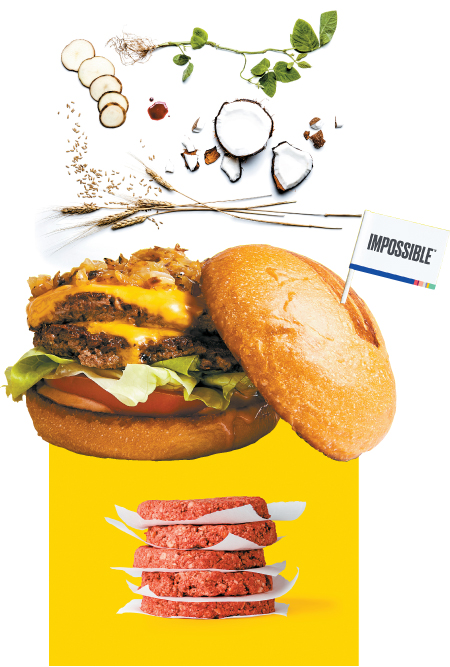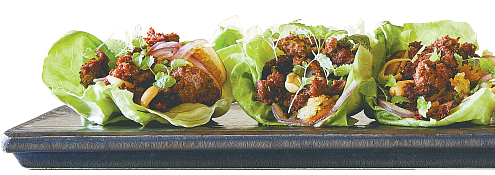California start-up brings meatless burger to Asia : In a nation of meat lovers, can a plant-based patty survive? Impossible Foods sees possibilities

Top: Impossible Foods found that combining coconut oil, wheat protein, potato protein and heme together creates flavors and aromas similar to beef. Middle: Umami Burger, a food chain in the U.S., serves burgers with patties from Impossible Foods. Above: A pile of plant-based beef patties from Impossible Foods. [IMPOSSIBLE FOODS]
Impossible Foods - which makes a product that tastes like ground beef, but is made from plants - is on the road to diversify its product portfolio to include something similar to steak. This long-term plan is to expand internationally next year from its headquarters in California. Its new target will be Asia, after gaining attention for its food technology in Silicon Valley, where it attracted funds from big names investors like Bill Gates of the United States and Li Ka-shing of Hong Kong.
Nick Halla, Chief Strategy Officer for the food technology company based in California, shared the company’s plan to focus on Asia during his visit to Korea last week at Demo Day 10, which was organized by startup accelerator Sparklabs. Halla met with the Korea JoongAng Daily to explain this new kind of veggie burger, which many Korean consumers have yet to taste.

Nick Halla, chief strategy officer for Impossible Foods. [SPARKLABS]
A. First, we did deep research on what makes meat, fish, diary what they are. And also why all the aromas and flavors that are so complex develops as you cook when your burger or steak is on the grill. And then we learn the drivers of that in meat is a protein called heme. That drives all the flavor chemistry of the meat and when you have all the aromas together, we perceive that food as meat. Instead of individually picking each of those several hundreds compounds that make the flavor of meat, from then, we just needed to find a plant source of heme and scale it.
Do many plants have that protein?
Every plant has it. The difference is concentration. Beef is very concentrated with heme and that’s why it’s red and vibrant. Among plants, it is less prevalent and it is not really scalable. So we found a way where we can do it by yeast fermentation.
So what are the key ingredients for your beef at the moment?
The wheat protein gives you the chew and the structure, the potato protein helps take the food from soft and malleable to firm as you cook. Coconut oil adds the richness, fattiness and the juice you get. And heme. Those are the main four ingredients.
Are you targeting vegetarians or vegans as a substitute for meat?
This is not a veggie burger. Some vegetarians and vegans will eat it, some won’t. But our target consumers are meat consumers and we had to find new ways to produce products that they would prefer. The way we look at it is, first, we have to create delicious food.
Delicious food is what is going to change the world and change the system. If we can’t give it to David Chang or any other top chefs at all these burger restaurants, it is never going to get anywhere. And also, going environmental [is a key] to really produce food scalable and sustainable for 10 billion people. Then you get to health and animal welfare. Those are the added benefits to some consumers who care about those things. One of our core principals is that we would never put a product on a market that is scientifically not healthier, but health is very difficult to prove. So for us, it is not about creating health food, but creating delicious food that’s better for the environment.

[IMPOSSIBLE FOODS]
We were initially at a few restaurants to really start building credibility that this is meat made in better way. Then we started going to burger chains where you can reach a lot more consumers, so we could be much more accessible.
How many restaurants can you serve?
We just opened our first production facility that takes us from 30, 40 restaurants to several thousand. We opened that up two months ago and now we are at over 300 restaurants. That produces a million pounds a month, which is you can say roughly, 0.1 percent of the U.S. ground beef market. You can take ground beef to make dumplings, tartare, meatloaf, meatballs...
We have started [serving] on campuses as well. We started initially at the University of Chicago. That’s where our founder went to school. We are starting to go to bunch of [college] campuses and corporate campuses too. That’s another way you can scale and reach more people.
Can you also eat the burger raw?
We have done very little on that side, because it is not as big of a market or application, but we had one French chef and she made tartare for the climate change summit in Paris two years ago. Since we were going to France, she wanted to do something French. And the reception to it was through the roof. Even at the climate change summit, very few people talked about food. So we went there to start that conversation. We are positioning ourselves and taking a lead that we have to drive this conversation how the animal product industry is one and a half trillion dollar industry and has huge environmental implications and expected to scale fast.
What’s your plan for the Asian market and how can people here incorporate your product into their meals?
Asia is one of the places we will be coming to next year. What we do in the U.S. right now is either deliver patties or 5-pound bulk bricks to restaurants and chefs. We are served in tacos, pastas, meatball sandwiches, and all these different ways that chefs use our products to make their food. As we are thinking about the Asian market, the application might be different. You can go for your favorite burgers in Seoul, but there will be other applications that will be much bigger here than they are in the U.S.
How far are you to create chunk of meat that one can actually grill like Korean barbeque style?
We do have prototypes of that nature. It will be more of a challenge further out, and from a research stand point, our team is very confident we will have solutions for that, actually in the pretty near future.
BY LEE SUN-MIN[summerlee@joongang.co.kr]










with the Korea JoongAng Daily
To write comments, please log in to one of the accounts.
Standards Board Policy (0/250자)